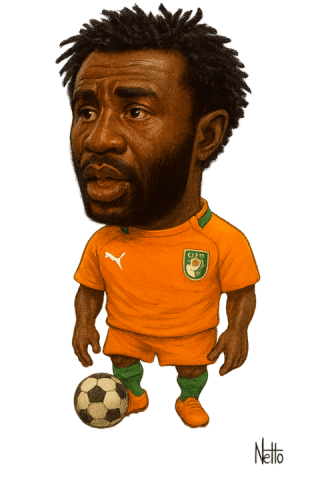As Swansea City prepare to face Manchester City, we turn the spotlight on a striker who wore both shirts with distinction and whose career arc mirrored the highs and lows of both clubs. This is the latest instalment of our Wore Both Colours series, which explores the journeys of players who have represented the Swans and our upcoming opponents.
Wilfried Bony’s story is one of power, promise and puzzling decisions. He arrived in SA1 as a record signing, left as a record sale and returned in circumstances that raised eyebrows. Between those spells, he wore the sky blue of Manchester City, scored goals in the Champions League and even managed to net twice against the Swans while on loan at Stoke.
From his early days in Ivory Coast to his post-football ventures, Bony’s journey is anything but ordinary. In this edition, we trace his rise through Europe, his explosive first spell in Swansea, the big-money move to the Etihad and the controversial return that coincided with relegation. We also look at what has become of him since and what lessons his story offers as the Swans prepare to face City once again.
🌍 The Early Years
Wilfried Bony was born on December 10, 1988, in Bingerville, a suburb of Abidjan in Ivory Coast. Football was part of his life from an early age, and he began honing his skills on the streets before joining the youth academy of Issia Wazi, a local club known for developing talent in the region. His physical strength and natural finishing ability quickly set him apart.
Bony’s potential earned him a place at the prestigious Cyril Domoraud Centre, a football academy founded by the former Ivorian international. It was here that he caught the attention of European scouts, leading to a trial with Liverpool in 2007. Although the move to Merseyside didn’t materialise, it marked the beginning of his journey into European football.
Later that year, Bony signed with Sparta Prague in the Czech Republic. The transition from West Africa to Central Europe was a significant cultural and footballing shift, but Bony adapted quickly. His early years in Prague laid the foundation for a career built on power, precision and a relentless eye for goal. From Bingerville to the Czech capital, Bony’s rise was already underway.
⚽ First Career Steps – Sparta Prague and Vitesse
Wilfried Bony’s European career began in earnest with Sparta Prague, where he signed in 2007 after impressing scouts during a trial. Initially placed in the reserve team, Bony quickly made his mark and earned promotion to the senior squad. His physicality, hold-up play and instinctive finishing gave Sparta a new dimension in attack. During the 2009–10 season, he scored nine goals in 22 appearances, helping Sparta win the Czech First League title.
His performances in Prague attracted interest from clubs across Europe, and in January 2011, Bony made the move to Vitesse Arnhem in the Netherlands. The Eredivisie proved to be the perfect platform for his development. Bony thrived in a more technical and attacking league, and his goal-scoring record exploded. In the 2012–13 season, he scored 31 goals in 30 league games, finishing as the Eredivisie’s top scorer and earning the Dutch Footballer of the Year award.
in the Netherlands. The Eredivisie proved to be the perfect platform for his development. Bony thrived in a more technical and attacking league, and his goal-scoring record exploded. In the 2012–13 season, he scored 31 goals in 30 league games, finishing as the Eredivisie’s top scorer and earning the Dutch Footballer of the Year award.
By the summer of 2013, Bony was one of the most sought-after strikers in Europe. His blend of power, composure and aerial threat made him a natural fit for the Premier League. Swansea City, fresh off their League Cup triumph and preparing for a Europa League campaign, saw in Bony the ideal forward to lead their line. The stage was set for a record-breaking move to SA1.
🦢 Swansea City Part 1
In July 2013, Swansea City broke their transfer record to sign Wilfried Bony from Vitesse Arnhem for £12 million. The move was a bold statement. Fresh from their League Cup triumph and preparing for a Europa League campaign, the Swans needed a proven goalscorer. Bony, who had just netted 31 goals in the Eredivisie, fit the bill perfectly.
Bony made an immediate impact. His physicality, hold-up play and clinical finishing gave Swansea a new edge in attack. In his debut season, he scored 26 goals in all competitions, including 20 in the Premier League. That tally made him the league’s top scorer in the calendar year of 2014. He also chipped in with seven assists, showing his ability to link play and contribute beyond the box.
In Europe, Bony played a key role in Swansea’s Europa League run. He scored six goals in the competition, including the opener in the famous 3–0 win over Valencia at the Mestalla. That night remains one of the club’s greatest away performances, and Bony’s early strike set the tone. He also found the net against Malmö, Petrolul Ploiești and Kuban Krasnodar, helping the Swans reach the Round of 32 where they were narrowly knocked out by Napoli.
By January 2015, his form had attracted serious interest. Manchester City made their move, signing Bony for £28 million. It was a record sale for Swansea and a moment that marked both the peak of Bony’s time in SA1 and the start of a new chapter at the Etihad.
🔵 Manchester City
In January 2015, Manchester City signed Wilfried Bony from Swansea for £28 million, making him the most expensive sale in the Welsh club’s history. The move was designed to bolster City’s attacking options as they chased domestic and European honours. Bony joined a squad stacked with talent, including Sergio Agüero, David Silva and Yaya Touré, his international teammate.
 Bony’s debut came in February, but his momentum was disrupted by a bout of malaria that affected his fitness and availability. Despite flashes of quality, he struggled to cement a regular starting place. Over two seasons, he made 46 appearances for City, scoring 11 goals in all competitions. His most notable contributions came in the Champions League, where he scored against Sevilla and Borussia Mönchengladbach.
Bony’s debut came in February, but his momentum was disrupted by a bout of malaria that affected his fitness and availability. Despite flashes of quality, he struggled to cement a regular starting place. Over two seasons, he made 46 appearances for City, scoring 11 goals in all competitions. His most notable contributions came in the Champions League, where he scored against Sevilla and Borussia Mönchengladbach.
The arrival of Pep Guardiola in 2016 signalled a shift in style and personnel. Bony was deemed surplus to requirements and left the club that summer. His time at the Etihad was marked by frustration and limited opportunities, a stark contrast to the prolific form he had shown in SA1. The £28 million fee remains one of the most debated transfers of the era, with many feeling City never truly unlocked the striker’s potential.
🔴 On Loan at Stoke
In August 2016, Wilfried Bony joined Stoke City on a season-long loan from Manchester City. The move was seen as a chance to revive his form and gain regular minutes, but it never truly clicked. Bony struggled for rhythm and consistency, making just 11 Premier League appearances and scoring only two goals.
Both of those goals came in a single match, against Swansea City. In October 2016, Bony netted twice in a 3–1 win at the bet365 Stadium, a bitter twist for Swans fans who had once celebrated his every touch. Beyond that brief flash, his time at Stoke was largely forgettable, and he returned to Manchester City at the end of the season with little fanfare.
🔁 Back to Swansea
In August 2017, Wilfried Bony returned to Swansea City for a reported fee of £12 million, almost exactly what the club had paid for him four years earlier. The move was met with mixed emotions. Some fans welcomed the return of a proven goalscorer, while others questioned the logic of re-signing a player whose form had dipped and whose wages were substantial.
Bony’s second spell at Swansea was plagued by injuries and inconsistency. He managed just 25 appearances across all competitions, scoring four goals. His most notable strike came against West Brom in December 2017, a late winner that briefly lifted spirits during a difficult campaign. But the magic of his first spell never returned.
The club’s fortunes were also in decline. Swansea were relegated from the Premier League at the end of the 2017–18 season, and Bony’s contract became a financial burden. He was released in 2019, bringing an end to a chapter that had started with promise and ended in disappointment.
🌐 After Swansea
After leaving Swansea City in 2019, Wilfried Bony’s career took him across continents in search of a final flourish. He joined Al-Arabi SC in Qatar on loan and scored five goals in seven appearances. The stint showed glimpses of his old sharpness but did not last long.
In early 2020, Bony signed with Al-Ittihad in Saudi Arabia. He added five goals in ten matches before the club and player parted ways by mutual consent. A long period without a team followed. During that time, Bony trained independently and spoke openly about his desire to return to top-level football.
In January 2022, he signed with NEC Nijmegen in the Netherlands. This marked a return to the Eredivisie where he had once dominated. The move was symbolic but his body could no longer match his ambition. He made just one appearance and did not score.
In 2023, Bony joined Always Ready, a Bolivian top-flight club. Despite the headlines, he did not feature in any competitive matches. The move marked the end of his playing career although no formal retirement was announced.
Internationally, Bony remained a respected figure. He earned 56 caps for Ivory Coast and scored 16 goals. His contributions during the 2015 Africa Cup of Nations were especially significant. His final appearance for the national team came in 2019 and closed a chapter that had brought pride to his country and recognition across the continent.
🧳 Life After Football
Wilfried Bony has never formally announced his retirement, but the signs are clear. His last competitive appearance came in early 2022, and his brief stint with Always Ready in Bolivia ended without a single match played. Since then, Bony has stepped away from the pitch and into a quieter chapter.
In interviews, he has spoken candidly about the toll injuries took on his body. “My body didn’t allow me more,” he told Flashscore in 2024, reflecting on the setbacks that disrupted his time at Manchester City and beyond. Despite the frustration, he remains proud of his journey and grateful to the clubs that shaped it.
There is no record of Bony taking on coaching or punditry roles, but he has expressed interest in mentoring young players. His experience across leagues in Europe, the Middle East and Africa gives him a rare perspective on the challenges faced by emerging talent.
He stays active on social media, occasionally sharing reflections and messages of support for former teammates. While his post-football path is still unfolding, Bony appears to be embracing a life of recovery, reflection and quiet connection to the game.
🧠 Legacy and Lessons
Wilfried Bony’s career is a study in momentum, timing and the delicate balance between talent and opportunity. At his peak, he was one of the most feared strikers in Europe. He was strong, intelligent and lethal in the box. His first spell at Swansea remains one of the most productive in the club’s Premier League history. His goals helped define an era of ambition and belief.
His journey also reflects the volatility of modern football. Transfers, managerial changes and injuries can shift a player’s trajectory in an instant. Bony’s £28 million move to Manchester City promised greatness but delivered frustration. His return to Swansea was heartfelt but ultimately unsuccessful.
For Swans fans, Bony is remembered with affection and a touch of sadness. He gave everything in his prime and returned when the club needed hope. His story is a reminder that football careers are rarely linear. Even the brightest stars can fade if the conditions are not right.
As Swansea prepare to face Manchester City once again, Bony’s legacy lingers. He wore both colours with pride. His journey was flawed, brilliant and human. It still resonates.

This article first appeared on JACKARMY.net.


13 replies
Loading new replies...
Youth Team Apprentice
Roger Freestone
Michu
Roger Freestone
First Team Player
Roger Freestone
Michu
Ivor Allchurch
Alan Waddle
Ivor Allchurch
First Team Player
Join the full discussion at the Welcome to the Lord Bony Stand →